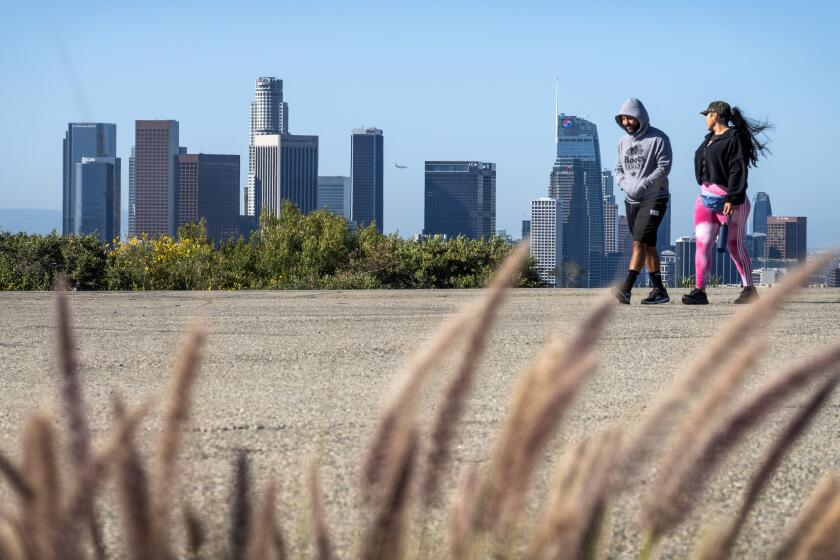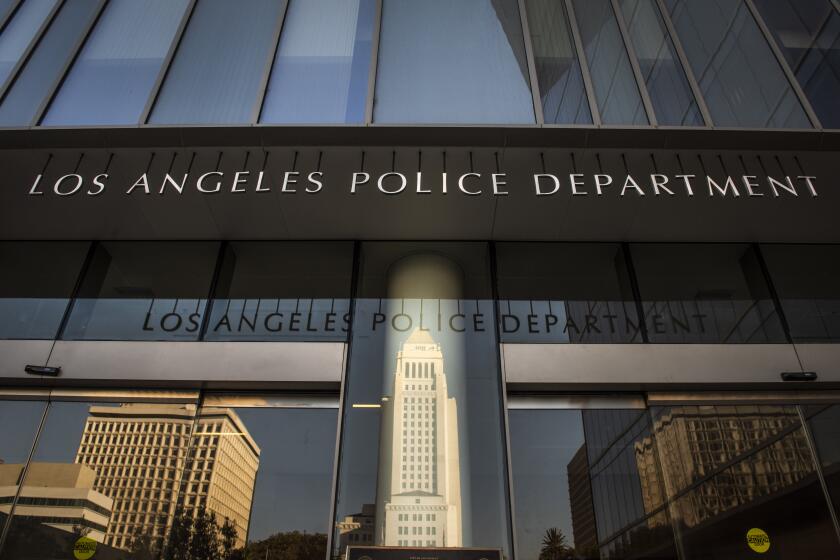Death of a Tagger a Typical Street Mystery for Police
The case had all the elements of a good mystery: a screwdriver, a paper cup, a piece of wire mesh, a corpse and two men with two different stories.
From these, authorities were asked to assemble the truth of what happened an hour past midnight on Jan. 31, when part-time actor William Masters shot and killed an 18-year-old tagger and wounded a second man.
Los Angeles Police Detective Mike Coffey--who directed the investigation--said detectives arriving at the freeway underpass in North Hollywood found a typical scene: “We had two people shot, (but) we had no idea of what transpired.”
An attorney for the surviving tagger calls it murder. Others, including prosecutors who declined to file charges in the killing, say it was justifiable homicide.
What’s clear is how the case illustrates the difficulties unraveling such street mysteries that routinely face police and prosecutors. Police documents and tape-recorded interviews from the case obtained by The Times demonstrate the inexact nature of the investigative process--where investigators must reconcile conflicting stories, often given by unreliable witnesses, and prosecutors must assess the chances of getting a conviction.
“You try to paint a picture from statements from everybody, and try and look at the whole thing and draw a reasonable conclusion,” Detective Coffey said.
But in this case, which quickly drew national attention, the picture was less than clear.
Masters, 35, says he fatally shot Cesar Rene Arce because he believed Arce was about to attack him with a screwdriver. But he first told police he shot Arce because he was tagging.
Surviving tagger David Hillo, 20, changed his story four times, conceding to detectives that he could understand why Masters panicked. But Hillo consistently denied attacking or threatening Masters.
Whether to charge Masters with murder depended on how much prosecutors believed his version of the confrontation. Was he fearful for his life? That would make the shooting self-defense. Or was his story the fabrication of a vigilante--one who had worked as an actor?
Attorneys defending Hillo against misdemeanor vandalism charges say racial bias on the part of police slanted their investigation to exonerate Masters, a charge department officials deny.
“If they had taken more time to investigate the case, they would have come to a different conclusion,” said Luis Carrillo, one of the attorneys representing Hillo.
Carrillo said detectives were less inclined to believe Hillo, a Latino dressed in baggy clothes, than Masters, whom one of the detectives described as “a white guy that looks like he belongs in England.”
Carrillo said Masters’ later statements to reporters--in which he bragged that he would continue carrying arms on his late-night walks--is proof that he was acting as a vigilante, looking to confront troublemakers.
Prosecutors say that short of a confession by Masters--that he shot Arce because he was spray-painting--he will not be charged with murder.
And even attorney Stephen Yagman--who has fought several high-profile legal battles with the LAPD--agrees with the way authorities handled the case.
“It’s a very difficult call,” Yagman said. “The D.A., for once, probably made the right call given all the appropriately considered elements.”
Based on police reports and interviews with Masters and Hillo, authorities established the following account of the confrontation:
At 12:55 a.m. on Jan. 31, police arrived at the desolate stretch of Arleta Avenue in Sun Valley where they found Masters and another man administering CPR to Arce.
An officer asked a sobbing Masters what happened and he replied: “I shot him because he was spray-painting,” according to the police report.
Police asked Masters for his gun, and Masters pointed to his fanny pack. Officers found a semiautomatic .380 pistol, and took him into custody.
*
Masters told police at the scene that while on his regular late-night walk, he saw the taggers and had jotted down their car’s license number. Masters then said he shot Hillo and Arce after they threatened him with a screwdriver and tried to rob him.
Masters did not tell officers at the time which tagger had the screwdriver.
Police also interviewed another man at the scene--passerby Ramon Tovar, 26. Tovar told them he had driven by and seen a man limping into a car. Believing there had been a crash, he called 911, then returned to find Masters standing over Arce. Tovar now says he believes Masters was acting when he started crying as police cars rolled up.
Officers then went to Sun Valley’s Pacifica Hospital at 1:45 a.m. where they found David Hillo, who was being treated for a gunshot wound to the buttock. Hillo first told police he had been wounded in a drive-by shooting.
Two hours later, during questioning by Detective Oscar Carballo, Hillo told a different story. Occasionally breaking into sobs, he recounted how he and Arce were confronted by Masters. He said he couldn’t recall exactly what happened the moment Masters pivoted toward Arce and opened fire, saying that Arce was closer to Masters than he was.
Carballo then asked Hillo about the screwdriver found at the scene, but Hillo said he knew nothing about it.
Coffey said Masters sat silently in a jail cell in the North Hollywood station after he was taken into custody, occasionally sobbing and refusing to speak with detectives. But at 6:35 a.m. he agreed to be interviewed by Carballo and Carballo’s partner, Detective Mark Aragon.
Masters said after jotting down the car’s license number, Arce approached him. The exchange between the two men, according to Masters’ interview with police, went like this:
“What are you writing down?” Arce asked.
“Your license plate number,” Masters replied.
“What you going to do that for?”
“To give to the police, so they can know who spray-painted the overpass.”
At this point, Masters’ and Hillo’s accounts diverge. Hillo told police he stayed on the Arleta Avenue median, about 25 feet from Masters. Masters said Hillo and Arce stood shoulder to shoulder before him.
Masters said Hillo then took out a screwdriver from his pants pocket and held it in a menacing way. Masters said he gave up the paper with the license plate number, and then Hillo demanded that he empty his pockets and hand over his wallet.
The detectives repeatedly questioned Masters about the screwdriver, asking if he was certain it was brandished by Hillo. Masters said he was.
Masters then told police he turned to walk away, but both Hillo and Arce followed him--Arce along the curb, Hillo walking in the street.
“I heard the sound of one of them following me,” Masters said in the police interview. “At that point, I decided I wasn’t going to be able to walk away. . . . I turned and shot into the chest of the closest.”
Masters said that as he fired, Arce spun away. The coroner’s report showed Arce was hit in the “left rear flank.” Then Masters fired at Hillo to disable him, saying he feared Hillo might attack him with the screwdriver or another weapon. He yelled at Hillo, then picked up the screwdriver with a piece of wire mesh he found at the scene, wanting to preserve evidence, Masters said.
Hillo limped into his car and drove off as Ramon Tovar arrived on the scene.
After interviewing Masters, detectives in a second interview with Hillo demanded to know if he carried a screwdriver. First, Hillo said he had one in his pants that must have fallen out. Then, after detectives told Hillo--falsely--that a security guard had witnessed the shooting, Hillo acknowledged that he had the screwdriver in his hand, but denied ever using it to threaten Masters.
Hillo said in a Times interview that he used the screwdriver as a tagging tool to scale signposts.
When Hillo admitted holding the screwdriver, he also made a statement that prosecutors later would say assured that Masters would not be charged with the killing.
“You had it in your hand?” a detective asked Hillo, referring to the screwdriver.
“Yeah, that’s probably why he panicked out--I, you know, I don’t blame the guy for panicking out,” Hillo said. “We have bald heads and everything, but . . .”
“Yeah,” the detective muttered.
“That’s no reason to shoot us,” Hillo said.
Deputy Dist. Atty. Bob Cohen, who made the decision not to charge Masters, said this exchange would have made it impossible to get a conviction.
“Our witness gives Masters, were he a defendant, a defense,” Cohen said. “He said, ‘I can understand why the guy panicked.’ How do I get around that? Impossible.”
Coffey also said Hillo was the only person besides Masters who could speak to Masters’ mental state. Masters “articulated and convinced” detectives that he was afraid he would be seriously hurt or killed by the taggers, Coffey said. “He convinced us only because there was nothing to refute it,” given Hillo’s statement.
Carrillo, Hillo’s attorney, argues that detectives subtly shaded their interrogation, asking Masters leading questions to place the taggers closer to him, according to tape-recordings of police questioning.
“They’re standing about three feet away,” Masters told Carballo during the interrogation, when asked where the taggers were when they demanded the paper. “Well, actually, they’re. . . .” He trailed off.
“They’re closer?” Carballo asked.
“Both of them,” Masters said.
Carrillo also complained that investigators never pressed Masters about his first statement to police, that he shot Arce “because he was spray-painting.”
Coffey said a person’s first statements to police after a crime are the most credible, acknowledging that Masters’ original statement was a concern. But Masters quickly elaborated on the statement and maintained a consistent story. Coffey himself interviewed Masters the next day and asked him to explain again why he fired at Arce, and Masters told the same story.
“No case is cut and dried. We saw that in Rodney King. It was on videotape, and there was an acquittal,” said former Dist. Atty. Robert Philibosian. “The fact that there’s doubt (as to what happened) goes to the benefit of the defendant. . . . Unless (prosecutors) have answers for the gray areas, they have an obligation not to prosecute.”
More to Read
Start your day right
Sign up for Essential California for news, features and recommendations from the L.A. Times and beyond in your inbox six days a week.
You may occasionally receive promotional content from the Los Angeles Times.






